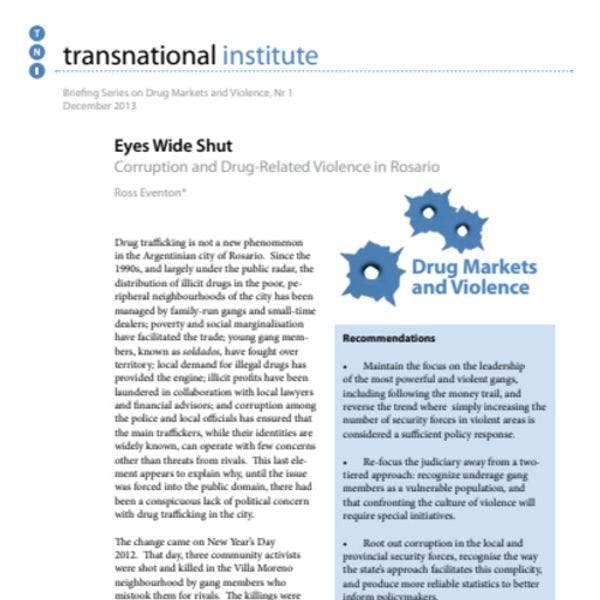Haciendo la vista gorda: Corrupción y violencia relacionada con las drogas en Rosario
Tras el asesinato de tres civiles inocentes a manos de una banda, la violencia relacionada con las drogas ha despertado la atención del Gobierno y de los medios de comunicación en la ciudad argentina de Rosario.
Más información, en inglés, está disponible abajo.
Suscríbase a las Alertas mensuales del IDPC para recibir información sobre cuestiones relacionadas con políticas sobre drogas.
Drug trafficking is not a new phenomenon in the Argentinian city of Rosario. Since the 1990s, and largely under the public radar, the distribution of illicit drugs in the poor, peripheral neighbourhoods of the city has been managed by family-run gangs and small-time dealers; poverty and social marginalisation have facilitated the trade; young gang members, known assoldados, have fought over territory; local demand for illegal drugs has provided the engine; illicit profits have been laundered in collaboration with local lawyers and financial advisors; and corruption among the police and local officials has ensured that the main traffickers, while their identities are widely known, can operate with few concerns other than threats from rivals. This last element appears to explain why, until the issue was forced into the public domain, there had been a conspicuous lack of political concern with drug trafficking in the city.
The change came on New Year’s Day 2012. That day, three community activists were shot and killed in the Villa Moreno neighbourhood by gang members who mistook them for rivals. The killings were not unique, but the victims were: unlike the usual casualties, the activists had a movement behind them. Their deaths led to local demonstrations and calls for action. The press and local officials were suddenly impelled to pay attention to drug trafficking and related violence. Since then, a spate of official investigations has deepened public understanding of the nature of the drug trade in the city. They have also provided further evidence of the complicity of the security forces and the negligence of the state that have long been known to facilitate trafficking.
Recommendations
- Maintain the focus on the leadership of the most powerful and violent gangs, including following the money trail, and reverse the trend where simply increasing the number of security forces in violent areas is considered a sufficient policy response.
- Re-focus the judiciary away from a two-tiered approach: recognize underage gang members as a vulnerable population, and that confronting the culture of violence will require special initiatives.
- Root out corruption in the local and provincial security forces, recognise the way the state's approach facilitates this complicity, and produce more reliable statistics to better inform policymakers.
Keep up-to-date with drug policy developments by subscribing to the IDPC Monthly Alert.
